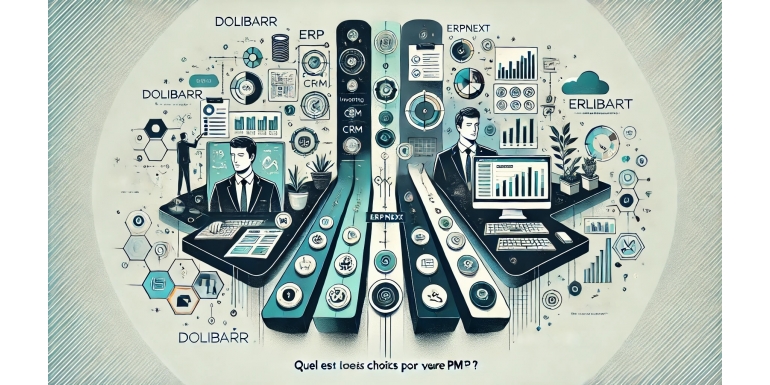
Introduction
Choosing an ERP (Enterprise Resource Planning) system is crucial for any SME looking to optimize management and automate business processes. Among the available open-source solutions, Dolibarr and ERPNext are two of the most popular options.
Dolibarr is valued for its simplicity and modular approach, while ERPNext stands out for its flexibility and advanced features for industry and stock management. But which of these ERP solutions is the best choice for your business?
In this article, we will compare Dolibarr and ERPNext, analyzing their features, advantages, and disadvantages to help you choose the solution best suited for your SME.
1. Overview of Both Solutions
1.1. Dolibarr: A Simple and Modular ERP & CRM
Dolibarr is an open-source ERP & CRM designed for small businesses, SMEs, and freelancers. It is known for its easy installation and intuitive interface, making it accessible to businesses without advanced technical skills.
Key Features of Dolibarr:
-
Customer and prospect management (CRM)
-
Invoicing and accounting
-
Stock and purchase management
-
Project and task management
-
Human resources and leave management
-
Customization through modules
One of Dolibarr’s biggest advantages is its modularity: you can activate only the features you need, avoiding unnecessary overload.
1.2. ERPNext: A More Advanced Solution for Industrial Management
ERPNext is an open-source ERP designed to meet the needs of industrial, commercial, and medical sector SMEs. It is more structured and offers an integrated approach to process management.
Key Features of ERPNext:
-
Advanced stock and manufacturing management
-
Complete accounting and financial management
-
Sales and purchase management
-
Human resources management
-
Customer relationship management (CRM)
-
Advanced reports and dashboards
ERPNext stands out particularly for its advanced production and stock management, making it an excellent choice for industrial SMEs.
2. Feature Comparison
2.1. Ease of Installation and Use
-
Dolibarr: Installing Dolibarr is very simple. It can be installed locally or online within minutes. Its interface is intuitive and does not require extensive training.
-
ERPNext: Installation is more complex and usually requires hosting on a dedicated server. Its interface is well-designed but takes time to master.
Verdict: Dolibarr is more accessible for businesses without an IT team.
2.2. Sales and Customer Relationship Management (CRM)
-
Dolibarr: Offers a basic but effective CRM module with quote management, invoicing, and customer tracking.
-
ERPNext: Provides a more advanced CRM with automation and more detailed opportunity tracking.
Verdict: ERPNext is better for businesses requiring a more sophisticated CRM.
2.3. Stock and Production Management
-
Dolibarr: Has a functional stock management module but is limited for businesses with advanced needs.
-
ERPNext: Offers advanced stock, purchase, and manufacturing management, with real-time stock level tracking and production planning.
Verdict: ERPNext is better suited for industrial and manufacturing businesses.
2.4. Accounting and Finance
-
Dolibarr: Simple and effective accounting module but with fewer options for advanced financial management.
-
ERPNext: Comprehensive accounting management with treasury integration, detailed reporting, and compliance with international accounting standards.
Verdict: ERPNext is more powerful in accounting, but Dolibarr is sufficient for a standard SME.
2.5. Scalability and Customization
-
Dolibarr: Highly modular thanks to its module ecosystem. Easy to customize according to business needs.
-
ERPNext: More scalable and flexible, with the ability to integrate specific developments and automate numerous processes.
Verdict: ERPNext is more scalable, but Dolibarr is easier to configure and use.
3. Advantages and Disadvantages
| Criteria | Dolibarr | ERPNext |
|---|---|---|
| Ease of Installation | ✅ Very simple | ❌ Complex |
| User Interface | ✅ Intuitive and lightweight | ❌ More technical |
| Sales Management (CRM, invoicing, sales) | ✅ Essential features | ✅ Advanced features |
| Stock and Production Management | ❌ Basic | ✅ Very advanced |
| Accounting and Finance | ✅ Simple but effective | ✅ Advanced accounting management |
| Scalability and Customization | ✅ Easy to customize via modules | ✅ Highly scalable with automation |
| Cost | ✅ Free (with paid modules) | ✅ Free (hosting required) |
| Support and Community | ✅ Active, many modules | ✅ Active, but more technical |
4. Which ERP Should You Choose for Your SME?
4.1. Dolibarr: The Ideal Choice for SMEs Looking for Simplicity
Dolibarr is recommended if:
-
You need an ERP that is easy to install and use.
-
Your SME operates in commerce, services, or project management.
-
You want a modular software without unnecessary features.
-
You seek a simple and efficient business management tool.
4.2. ERPNext: A Powerful Solution for Industrial Companies
ERPNext is recommended if:
-
Your SME is in the industrial sector or manages large stock volumes.
-
You require advanced production and accounting management.
-
You need a scalable ERP with extensive automation.
-
You have a technical team to manage installation and configuration.
Conclusion
The choice between Dolibarr and ERPNext mainly depends on your needs and industry. Dolibarr is the best option for SMEs looking for a simple, cost-effective, and modular solution. ERPNext, on the other hand, is better suited for industrial businesses with advanced stock and production management needs.
If you need a solution that is quick to implement and easy to use, Dolibarr is your best choice. However, if your business has advanced needs and you can invest time in configuration, ERPNext can be a powerful alternative.
So, Dolibarr or ERPNext? The choice is yours based on your goals!
